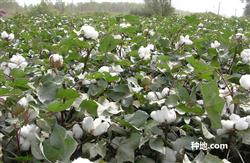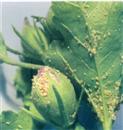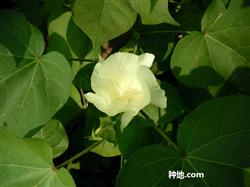How can cotton yield increase and disease resistance?

How can cotton yield increase and disease resistance? What's the trick? After investigation in some cotton areas, it is found that only about 45% of cotton farmers apply nitrogen, phosphorus and potassium compound fertilizer, and most farmers use ammonium bicarbonate, urea and calcium superphosphate, of which about 15% only use phosphate fertilizer as base fertilizer. This situation shows that many cotton farmers in cotton areas do not pay attention to potassium application, which is not conducive to high yield, high quality and high yield of cotton. According to the data, for every 50 kg lint production, it is necessary to absorb 9 kg of pure nitrogen, 3 kg of pure phosphorus and 8 kg of pure potassium from the soil. If 100 kg of lint is produced, 13 kg of pure nitrogen, 4.5 kg of pure phosphorus and 13 kg of pure potassium are needed. It can be seen that the ratio of cotton to cotton is 1 ∶ 0.35 ∶ 1, which also shows that cotton is a potassium-loving crop. The cotton production practice in recent years shows that no matter which kind of insect-resistant hybrid cotton varieties have a large demand for potash fertilizer, especially in the case of continuous cropping, special attention should be paid to the supplement of potash fertilizer. Potassium application can enhance the physiological activity of cotton, improve the utilization rate of nitrogen fertilizer, promote the growth of cotton roots, stems, leaves and reproductive organs, prolong the functional period of leaves, and prevent premature senescence. Especially in the cotton area with serious Fusarium wilt, potassium application can enhance the disease resistance and stress resistance and reduce its harm. Because potassium is very active in cotton plants, it can be replaced and replaced with other elements, which is beneficial to enhance the concentration of cell sap and membrane permeability, so as to promote the absorption and synthesis of nitrogen and phosphorus, and improve the cold tolerance and economic water use capacity of cotton. It has a very defensive effect on early sowing cotton and cotton planting in arid areas. In production, due to people's heavy nitrogen and light potassium, the cotton field soil can not get the supplement of potassium nutrition, coupled with the predatory management of the soil year after year, the potassium resources in cotton soil decrease year by year, which hinders the transport and transmission of nutrients in cotton. As a result, the yield has decreased year by year, which has become an obstacle factor restricting the high yield of cotton. The potassium deficiency of cotton first showed yellow-white patches on the leaves, then the leaves gradually became light green, yellow spots appeared between the leaf veins, and the central part of these spots died first. At the same time, there are many brown stains at the tip and edge of the leaves, which fester and roll down, and finally the whole leaves turn brown, and finally dry up and fall early. The lateral roots of potassium-deficient cotton plants are also significantly shorter, the root quantity is also less, the stems are short and thin, the bud and boll shedding aggravates, the bolls are few, and it is difficult to mature and open bolls, the fiber quality decreases, and the cotton plants with serious potassium deficiency die prematurely due to too many leaves falling too early, that is, the so-called red leaf stem withered prematurely. Even if some big peaches are produced, a large number of big bolls will fall off in the later stage, resulting in a serious reduction in yield. The phenomenon of potassium deficiency in cotton is more common, but it can not be exposed until the later stage, and by that time it is too late to apply potassium fertilizer, so it should be emphasized to increase the application of organic fertilizer in cotton fields which have always been deficient in potassium. In addition, according to the application of nitrogen and phosphorus in cotton field, a certain amount of potassium fertilizer should be applied, the amount of potassium application per mu of cotton field is not less than 15 kg, and the amount of potassium deficiency cotton field can be increased to 20 kg to 25 kg. The suitable input ratio of nitrogen, phosphorus and potassium should be 1 ∶ 0.3 ∶ 0.8 to 0.9. The specific application is: on the basis of applying 2500 kilograms of high quality farm manure per mu during sowing or transplanting, and then mixing potassium chloride or potassium sulfate 10kg 15kg, or plant ash 40kg 50kg or potassium dihydrogen phosphate 2kg 3kg as base fertilizer, it can meet the needs of potassium in the whole growth stage of cotton. For cotton fields with insufficient potassium fertilizer in the early stage, 10kg potassium chloride can be applied in bud stage and 5kg potassium chloride per mu in flower and boll stage. In the middle and later stage, due to the weakening of root absorption capacity, 0.2% potassium dihydrogen phosphate can be foliar sprayed for 2 times for 3 times. Spraying 50-60 kg fertilizer solution per mu can not only enhance the stamina of cotton and prevent premature senescence, but also play the role of more peaches and big peaches, which is an important measure to improve the yield and quality of cotton. Click to get massive cotton planting technology click to get massive grain and oil crop planting technology
- Prev

How to top cotton?
How to control cotton aphids? Is there any effective way to use it? The control of cotton aphid should be based on the occurrence of local control, spot should be selected when the occurrence of treatment, do not spray all over the field, so as not to kill natural enemies. Chemical control should be carried out in time for the fields that reach the control target, and 35% Saidan EC is generally selected for 100-16 per mu.
- Next

* * how to control cotton stem wood sac moth?
What diseases are there in cotton boll period? How to prevent and cure it? How to control cotton boll disease? Occurrence, climate and variety of cotton boll disease. There is a close relationship between insect pests and cultivation techniques during the growth period, so the prevention and control of cotton boll diseases should be based on cultivation management combined with chemical protection. (.)
Related
- The first cup of black tea in spring, the flavor and history of tea gardens in Kenya, Africa
- The computer can not only choose potatoes, but also grow tea rice. AI will grow winter oolong tea champion.
- It is not only the inflated tea bitten by insects, but also engraved with the four seasons tea in Beipu.
- The Oriental Beauty Tea Festival in Zhuxian County takes the stage at the weekend to experience the plus-size feast of oil tea.
- & quot; Oriental Beauty Tea & Exploration of Emei in Hsinchu, the hometown of quot;
- The new variety of strawberry "Tainong 1" dessert is the first choice with mellow aroma. Crimson gorgeous
- History of Tea in Taiwan: from Wild Inner Mountain to Export Tea Garden
- Two types of Taiwan Oriental Beauty Black Tea won the British three-Star Award for Childhood Tea Xiang Zhang Jiaqi changed from pilot to champion tea maker.
- Banana species and varieties: the planting history of Taiwan Xianren banana and dwarf banana is long, is banana disease resistant?
- Coffee planting Technology: Qianjie Coffee from Seedling to harvesting

